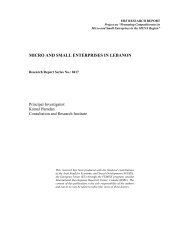View - ResearchGate
View - ResearchGate
View - ResearchGate
Create successful ePaper yourself
Turn your PDF publications into a flip-book with our unique Google optimized e-Paper software.
term, the first four lags of growth, and the conditional variance of growth (growth volatility). 5<br />
In the first part of Table 1, the coefficient of growth volatility in the equation is negative and<br />
statistically significant at the 5% level, 6 which suggests that growth volatility adversely<br />
affects growth for Turkey. This finding is consistent with Bernanke (1983), Pindyck (1991),<br />
Ramey and Ramey (1991 and 1995), Aizenman and Marion (1993), Martin and Rogers<br />
(1997), Caballero (2000), and Talvi and Vegh (2000). Similar to the AR specification, the<br />
coefficients for the lag values of the growth variable are not interpreted because they are used<br />
to capture the dynamics of the series. For the estimates of the EGARCH specifications, the<br />
lag value of the logarithmic conditional variance (log h t-1 ) is positive and less than 1,<br />
suggesting that the conditional variance is non-explosive (Hamilton, 1994) 7 . The estimated<br />
coefficient for the leverage effect (δ) is positive and significant at the 10% level. This<br />
suggests that positive shocks increase volatility more than negative shocks for Turkey.<br />
After we obtain the negative relationship between GDP and GDP volatility, we consider four<br />
variables that are crucial for growth using the two-variable multi AR-ARCH models. The<br />
estimates of the model are reported in Table 2. These four variables are TFP, investment,<br />
depreciation, and employment. We consider these variables transmission variables.<br />
Panel A of Table 2 reports the estimates of the growth specification, Panel B reports the<br />
estimates of the transmission variable, and Panel C shows the estimates of the conditional<br />
variance specification of the growth equation. Column 1 of Table 2 reports the estimates that<br />
use GDP growth and the first transmission variable that we consider (TFP). The estimated<br />
growth equation includes the first three lags of growth and the conditional variance of growth<br />
(growth volatility). 8 Note that the estimated coefficient for growth volatility is negative and<br />
statistically significant in the growth equation. This same finding in Table 1 indicates that<br />
growth volatility has an explanatory power for growth. Coefficients for the constant term and<br />
the lag values of growth were not interpreted the same way as in an AR specification, as these<br />
are used to capture the data-generating process. We will not elaborate on the effect of growth<br />
volatility on growth when we incorporate the other transmission variables, but the results are<br />
robust.<br />
In Panel B, the next set of coefficients reported in Column 1 is for the transmission variable<br />
TFP. As suggested by the FPE criteria, TFP is modeled with a constant term, its two lags, and<br />
growth volatility. The estimated coefficient for growth volatility is negative and statistically<br />
significant. This suggests that uncertainty in growth decreases TFP, which is consistent with<br />
the theory of a negative relationship between volatility and growth through the productivity<br />
channel (see Martin and Rogers, 1997; and Talvi and Vegh, 2000).<br />
The second column of Table 2 is for the analysis that uses GDP growth and investment as a<br />
second transmission variable. Panel B of Column 2 is for the investment equation. The<br />
estimated coefficient for the growth volatility is statistically significant and negative (i.e.,<br />
growth volatility decreases investment), suggesting that growth volatility decreases output via<br />
investment. This supports the irreversible investment argument of Bernanke (1983) and<br />
Pindyck (1991) and the empirical study by Aizenman and Marion (1999).<br />
5<br />
The order of the AR process is determined by the Final Prediction Error (FPE) criteria. Jansen and Cosimona (1988) argue<br />
that autocorrelated residuals wrongly indicate the presence of the ARCH effect. The FPE criteria determine the optimum lag<br />
such that the residuals are no longer autocorrelated; thus the selection of the FPE eliminates this problem.<br />
6<br />
The level of significance is at 5%, unless otherwise noted.<br />
7<br />
For our specification, we also conducted a set of non-parametric robustness tests that did not reject our specification. These<br />
tests are available from the authors on request.<br />
8<br />
The lag orders both for growth and transmission variables are chosen using FPE criteria. The specification of the<br />
conditional variance equation is the same as the one reported in Table 1.<br />
6

















